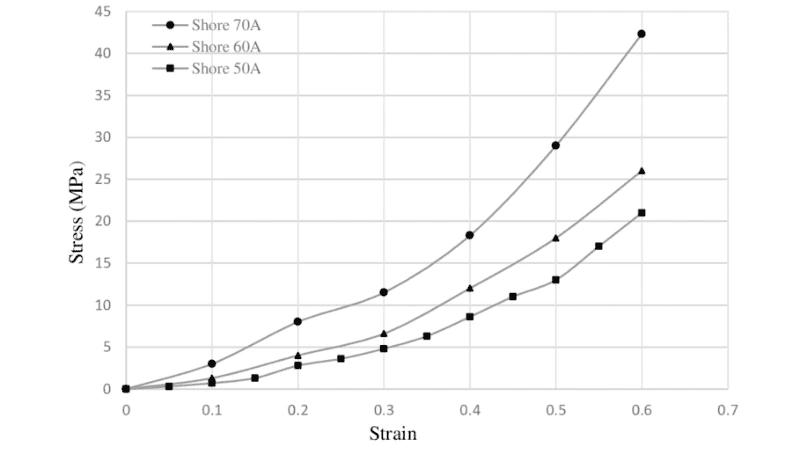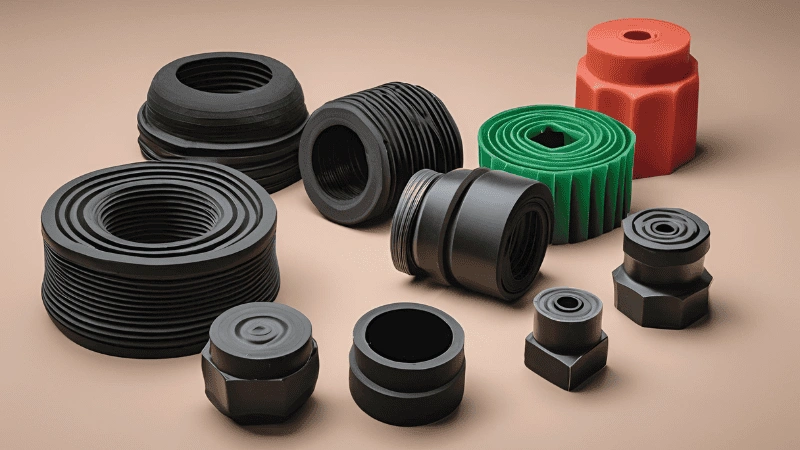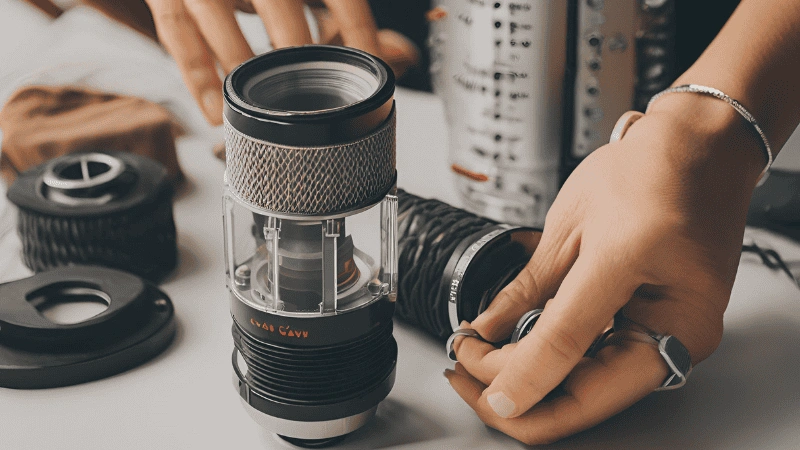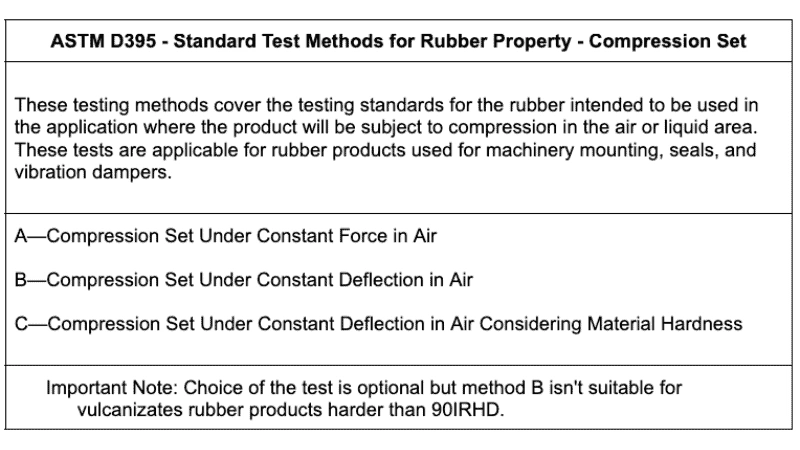So, let’s dive into the world of compression sets in rubber products. In this guide, we plan to tell you what compression set is in rubber products, how it’s measured and works, and some industry-standard tests.
We plan to share some example calculations to understand high and low values and their meaning. Besides, you would enjoy reality checks of some misconceptions about compression sets. Are you ready to comprehend the concept of a compression set? Let’s begin!
What is a Compression Set?
Compression set measures the material’s ability to bounce back to its original shape and size after it is compressed and squished under pressure for a specific period.
For example, if you squeeze a rubber ball so hard for a long time that it doesn’t bounce back to its round shape and stays squished, then this ball has a high compression set, which makes it less ideal for applications.
Compression set is an important characteristic of rubber products, especially when rubber is used to make gaskets, seals, and tires. These products must maintain their shape and work even when squeezed for a long time.

A high compression set is when a material loses its shape and size under compression for a specific time. However, a low-compression set of rubber products means the product returns to its original form after a long compression period.
A low compression set is better than a high one because it maintains a tight seal and ensures that tires grip the road properly. A high compression set may result in deformation and a leak.
The compression set in rubber products is a test that measures how well they spring back to their original shape after being squeezed or compressed. If they bounce back without losing much shape, then it tells us that they will perform their job effectively.
How Does a Compression Set Work?
The compression set test was performed on the rubber to measure the rubber’s ability to recover its original shape and size after being squished under pressure. This compression set test evaluates the resilience and durability of rubber over time.
Here is how the compression set test works:

- Initial Compression
In the first step, the rubber specimen is compressed to a specific pressure level by pressing it between two flat surfaces. This pressure mimics the conditions that rubber experiences over time during its use.
- Holding the Compression
The rubber is pressed for a specific period, such as 24 hours or even days. The time is based on the testing standard and intended application of the product.
- Release and Measurement
Once specified time passed, the product is released from the pressure, and then it is allowed to bring back to its shape. The amount it returns to its original shape is the compression set value, measured as a percentage.

A low compression set means the rubber product has good elasticity properties and can recover well to its original shape.
A high compression set means the rubber product doesn’t bounce back as effectively as needed. It indicates that the product has a potential issue with its long-term performance.
Inquire About Our Silicone and Plastic Products!
Importance of Compression Set in Rubber Products
Manufacturers perform compression set tests to ensure rubber products maintain their shape under pressure and function properly over time.
Compression set value is directly connected with the safety, performance, and longevity of different rubber-based applications. Here are some reasons that define the importance of compression sets in rubber products.
- Maintains Sealing Integrity: Rubber products must maintain tight seals to prevent leaks or contamination, especially when applying o-rings, seals, and gaskets. So, a low compression set ensures that the seal will remain intact and the system will maintain its integrity.
- Enhances Durability: Rubber-based products such as tires and suspension components often encounter great pressure and compression when used. So, a low compression set value ensures tires bounce back to their original shape. Therefore, tires made of rubber will remain safe and durable over time.
- Quality Control: Manufacturers perform compression set tests on rubber products before using them. They must choose high-quality rubber products to meet customer expectations and industry standards. A low-compression set of products means that it is of high quality.

- Safety Assurance: Rubber products have critical applications in aerospace components, industrial machinery, and medical devices. The compression set value defines the level of safety a product can offer.
- Cost Savings: High rubber products with a low compression value need less frequent replacement and repairs, leading to cost savings.
Measurement of Compression Set
The compression set of rubber products is measured by the following two testing procedures:
Compression Set A
It is the measure of compression set when the specimen is under a constant air force of 1.8kN.
During this test, the sample product is compressed for a specific period and at a set temperature under a constant force of 1.8 kN.
After the force is released, the product is given 30 minutes to spring back to its normal condition before its final thickness level is measured.
The formula for calculating the compression set is as follows:
Compression set A Value = [(t0-t1)/t0] X100%
Where:
- t0 =original thickness or height of the sample
- t1 = height/thickness of piece after specified time compression and time
For example:
Before compression, the sample’s original height is 25mm, and after compression for 24 hours, the height of the material is 20mm. Now, let’s apply the formula to get the compression set value.
Here is the calculation:
Compression Set A = [(25-20)/25] x100% = 20%

Compression Set B
It is the determination of the compression set after a constant deflection in the air.
During this test, the sample product is subject to constant air deflection almost 75 percent of its original height for a specific time and temperature. The product is allowed to rest for 30 minutes, then its thickness is measured. The percentage of the sample’s final thickness maintained after being released from compression is then measured.
The formula for the calculation of compression set b is as follows:
Compression Set B = [(t0-t2)/t0-tn] x100%
- t0 = Original thickness/height of sample
- The height/thickness of the sample product during the test
- t2= height/thickness of sample after the specified time and a subsequent recovery period
For example:
The original height of the sample is 25mm, and it is compressed 75 percent for almost 24 hours. After the test height of the product is measured, and it is 23.5mm. 75 percent of 25mm is 18mm.
Here is the calculation:
Compression Set B Value=(25-23.5)/(25-18.75) x100 % =24%
Inquire About Our Silicone and Plastic Products!
Factors Influencing Compression Set
Here are some factors that can influence the value of the compression set:
- Rubber Type: The chemical composition of rubber varies from one type to another. The compression set value of natural rubber will be different from synthetic rubber. Other types of rubber have varied levels of resistance to permanent deformation.
- Temperature: Rubber material has a high compression set value at high temperatures. Normally, tests on rubber products are performed under elevated temperatures to simulate real-world conditions. These multiple test methods offer insight into how well this product will perform under varied temperature levels.
- Compression Time: Another thing that can influence the compression set of a rubber product is the duration of compression. A compression set is high when a product gets compressive force for a long time. This high compression time results in permanent deformation as well.

- Compression Pressure: The magnitude of pressure and stress applied to a rubber product also affects the compression set. Higher comparison leads to greater deformation.
- Rubber Ageing: When rubber ages and gets exposed to sunlight, oxygen, or chemical reactions, this aging also becomes a reason for the high compression set.
- Fillers and Additives: Depending on their type and concentration, silicone rubber with filler or additives can increase or decrease the compression set.
- Curing Process: Another thing that can influence compression set value is the curing process of rubber products. When they are cured properly, the product maintains a high level of elasticity, and it is highly resistant to deformation.
- Design and Geometry: The design and geometry of rubber components also influence how well they respond to compression.
Standards and Testing Methods of Compression Set
Compression set testing for rubber products are based on the standard procedure developed by renowned organization such as STM International and ISO (International Organization for Standardization).
Although there are many standards and testing procedures, we would like to share details of two common standards and testing methods used to determine the value of compression set for rubber compounds.

ASTM D395 – Standard Test Methods for Rubber Property – Compression Set
It is the most commonly used standard for testing rubber products for various applications. This standard sets some guidelines to measure the compression set of material. ASTM D395 brings different kinds of testing done on rubber products at room or elevated temperatures.

ISO 815 – 1:2019 Rubber, vulcanized or thermoplastic – Determination of compression set testing
This ISO standard sets some guidelines for testing compression sets of vulcanized and thermoplastic rubbers at room/ambient temperature and elevated temperature.
ISO 815 – 1:2019 Standard of Compression Set
There are three testing methods for elevated temperature and one method of testing for room temperature. The purpose of this method is to measure the ability of rubber of hardness (10 IRHD to 95 IRHD range) to retain its elastic properties after prolonged compression for a specified time.
| Rubber Hardness | Compression Strain |
|---|---|
| 80 IRHD to 89 IRHD | 15 Percent |
| 90 IRHD to 95 IRHD | 10 Percent |
ISO 815 – 1:2019 Standard for Compression Strain
| esting Period | Hours | Temperature | Measure |
|---|---|---|---|
| Short | 24 hours | Elevated | State of the cure |
| Short | 24 hours | Ambient | The effect on the physical changes of rubber |
| Long | 1000 hours | Elevated | Measure the effect of aging and predict service performance |
Testing Parameters
Both standards specify equipment, calculation formulas, and testing conditions to measure the compression set value for the rubber material. Manufacturers and engineers use these standard guidelines to assess the suitability of rubber materials for various applications, ensuring that they meet performance and durability requirements.
Inquire About Our Silicone and Plastic Products!
Common Misconceptions About Compression Set
Certain things could be improved about the compression set that may lead to incorrect material or application selection. It’s time to shed light on this compression.
Misconception: Higher Compression Set Indicates Better Formability for Fine Detail Work
Reality: It needs to be more accurate. The higher compression set value means the material is less likely to return to its original shape after compression. This material is more formable initially, but can permanently deform when exposed to continued compressive forces.
So, if you need a rubber product for fine detail work, choosing a product with low compression set value is good.

Misconception: Rubber Is More Elastic Than Steel Due to Flexibility
Reality: Elasticity refers to a characteristic of rubber that determines how well the material bounces back to its original shape after deformation. Rubber is highly flexible, but it may not be as flexible as steel.
Steel is more elastic than rubber as it can return to its original shape more effectively. Rubber is highly flexible, but it can deform easily. So, it doesn’t mean it’s more elastic.
Misconception: O-Ring Compression Set Failures Are Solely Due to Material Issues
Reality: Many different factors contribute to the failure of the O-Ring compression set. The material must be compatible with system chemicals.
However, it’s not the only factor. Another thing that can cause failure is the level of squeeze or compression applied to the O-ring. When selecting an O-Ring, you need to reduce excessive squeeze to prevent its failure over time.
Inquire About Our Silicone and Plastic Products!
Conclusion
Finally, you have a complete picture of the compression set in rubber products. For example, what it is and how important is low compression set value. You know the formula that helps you measure the value with Compression Set A and B methods.
Besides, you understand what factors can influence the compression set value and what standards are followed for testing. It’s always a good idea to carefully select elastomeric materials and not let some misconceptions cloud your judgment.
When dealing with a compression set of rubber products, you must keep your facts straight because misconceptions may lead to the wrong choice of material for a specific application.
Get Top-Of-The-Line Rubber Products From Hongju
Compression set values from one rubber type to another. You can decrease this value by changing the rubber’s curing process and geometry. The idea of picking the right compression set for your application seems complex.
But worry not, our material science experts at Hongju are there to guide you every step of the way. You can share your project requirements with our team, and let us select the most durable and effective rubber product with the appropriate compression set value for you. Book a Consultation Now!